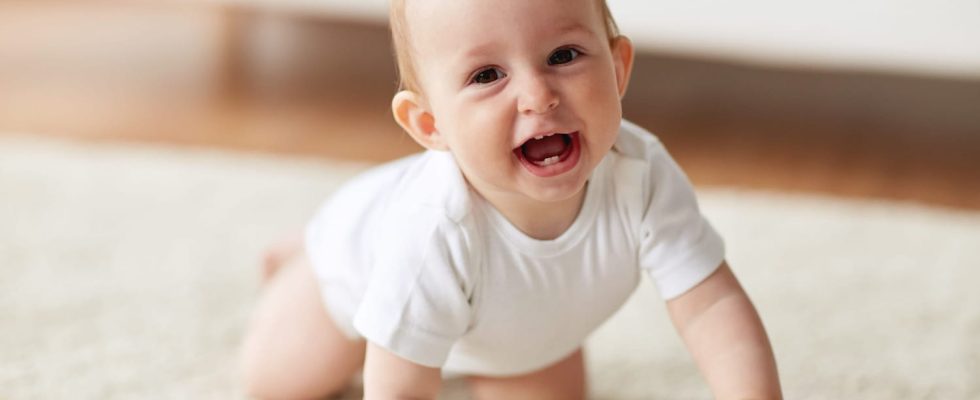The moment when baby crawls and begins to crawl is an important milestone in motor development. At what age does baby crawl? What exercises to put in place to help him? When should you worry? Answers and advice from Chloé Devie, pediatric physiotherapist.
Before even knowing how to walk, baby learns to move by crawling around 8 months, first on the stomach while moving backwards, then moving forward until do 4 legs. The stage where the child crawls can sometimes be very short and is linked with the 4 legged position. In any case, these modes of movement help baby to build up muscles and refine the coordination of his movements before he begins to learn to walk. But should you be worried if baby only crawls on one side or with only one leg? What to put in place to help baby crawl? Answer items with Chloé Devie, masseur-physiotherapist in pediatrics in Paris.
At what age does a baby crawl on his stomach?
“Not all children have the same rhythm”, reminds Chloé Devie, but usually baby starts crawling on tummy around 8 months. “At this age, the child begins to move on the ground, to crawl and often, before that, there is a phase where he crawls backwards, then, afterwards forwards”, details the specialist. Other children remain seated and move with sometimes astonishing speed on their buttocks.
“Often there is a phase before that where baby crawls backwards, then forwards after.”
At what age does a baby crawl?
“After having learned to crawl backwards and forwards on the belly (around 8 months), the child then moves on to 4 legs“says the expert. First there is a phase where baby adopts the 4-legged position while remaining static, without moving, then the child will move forward on all 4 legs. Concretely, it is a sequence of steps.
This 4-legged stage is also a phase of exploring the ground and avoiding objects. “The child will become aware of the distance between the ground and his head, and he will have reflexes to protect his head or if he falls”, she points out.
My baby only crawls on one side, on one leg, is it serious?
If your baby is only crawling on one side, on one leg, this may be the sign of a pathology that causes difficulty in moving around. But before you panic, it’s worth consult a health professional For “eliminate pathologies, looking for an asymmetry, a right-left imbalance“, indicates the masseur-physiotherapist.
“It is important for the child to go through the 4-legged phase and to have symmetrical motor skills. At this age, the child develops his body confidence, his right side and his left side, his proprioception (the perception of the different parts of his body, editor’s note), its balance even on 4 legs”, she expands.
“When you have a baby who follows the motor development perfectly, it is not worth assisting him. But if you notice an asymmetry or any problem, it is important to guide baby in its stages of motor development”, states Chloe Devie. In this case, you can easily help your baby to progress and gain self-confidence. At home, you can do with baby:
- Lateral and rotational stretches
- Lean him on his arms
- Rolling postures
- Group the knees on the body of the child to round his pelvis
- Wheelbarrow-type exercises while supporting the child well
- Place his favorite toys in front of him, to motivate him to pick them up
- Put cushions on his course, which will allow him to improve his agility
“These are exercises to learn with a physiotherapist, which depend on the level at which the child is in his development”she adds.
When to worry if baby isn’t crawling yet?
If baby takes a little longer than average to crawl, there is not necessarily cause for concern. This is all the more true in premature babies, who often need more time to acquire sufficient muscle mass and coordination to move forward… As a precautionary measure, however, it is advisable to consult a pediatrician if, around the age of 12 months, baby does not master the use of his legs and arms at all.
“If, however, you notice an asymmetry in the child, it is important to first speak to the pediatrician, who will then refer you to a pediatric physiotherapist, a pediatric orthopedist or to a neuropediatrician”, advises the specialist. The health professional will then check that there is no pathology: body asymmetry, body weakness on one side, an injury caused during childbirth or hip dysplasia.
Thanks to Chloé Devie, massage therapist in pediatrics.
